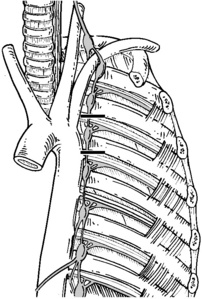CHAPTER 28 Thoracoscopic Sympathectomy
Introduction
Thoracoscopic sympathectomy has been used for the treatment of sympathetic dysfunction since it was first described by Kux and colleagues in the 1940s.1 With the advent of video-assisted thoracic surgery (VATS), the procedure has become more widely applied.2 VATS allows excellent visual acuity and the possibility of doing the procedure more quickly and with fewer complications. It is the most effective treatment for palmar hyperhidrosis.
Nomenclature
♦ Ablation: procedures in which the chain is destroyed using electrocautery or laser without directed division.
♦ Clipping: placing one clip above the ganglion; placing one clip each above and below the ganglion; placing a clip across the nerve over the middle of the rib; or placing clips above or below the ganglion.3
♦ Sympathicotomy: division of the sympathetic chain without removal of any section thereof. Unless otherwise specified, this excludes ablation techniques that are done without a directed division of the chain.
♦ R2 sympathectomy or sympathicotomy: division or resection of the chain overlying the second (R2 rib) and third rib (R3). This division accomplishes isolation of the R2 ganglion, which is found in between the two cuts (Figure 28-1). This nomenclature should be used for all subsequent levels; for example, R3 sympathectomy or sympathicotomy means division of the nerve chain over the third and fourth ribs, achieving R3 ganglion isolation.
♦ Thoracoscopic procedure: done with any means of thoracoscopy, including video-assisted and standard eyepiece-assisted procedures.
♦ Video-assisted thoracoscopic surgery (VATS): procedure using a video camera to help with visualization of the intrathoracic cavity.
Approach to Video-Assisted Thoracoscopic Sympathectomy
Choice of Transection Level
♦ Facial sweating: The R2 level is isolated by dividing over the R2 and R3 ribs. Alternatively, some surgeons treat facial sweating or blushing with division of the chain over the R2 rib, taking care to avoid injuring the stellate ganglion, although the lower third of the stellate ganglion can be transected without causing Horner’s syndrome.




